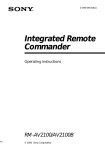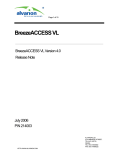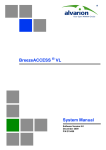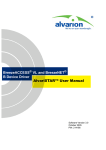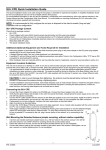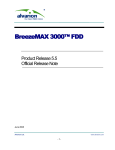Download Alvarion BreezeACCESS VL Specifications
Transcript
® BreezeACCESS VL BreezeACCESS VL Family Ver.6.6 GA Release Note August 2011 © Alvarion Ltd. All rights reserved. The material contained herein is proprietary, privileged, and confidential. No disclosure thereof shall be made to third parties without the express written permission of Alvarion. Alvarion reserves the right to alter the specifications in this publication without prior notice. BreezeACCESS VL Ver. 6.6 GA Release Notes Page 1 of 6 General This document details the main features, known limitations and other important notifications with respect to BreezeACCESS VL product Release 6.6. It corresponds to software versions: • VL-AU and VL-SU software version: 6.6.2 • VL-SU-Lite software version: 3.1.12 (unchanged) BreezeACCESS VL Release 6.6 is supported starting from Device Driver version 3.5.10.23 of AlvariSTAR and AlvariCRAFT. AlvariSTAR DD 3.5.10.23 version has to be installed on AlvariSTAR Infrastructure platform version 4.8.3.335. SU-L units are produced with version 3.0.6. In order to benefit from the full functionality of the latest releases, please upgrade the SU-L units to version 3.1.12. Release Notes for SU-L version 3.0.6 are available on Alvarion – Product Support web for registered partners or with your local distributor. Frequency Bands The currently supported frequency bands: • 5.8 GHz Band: 5.725–5.875 GHz (Universal Country Code with HW Revision C) 5.725–5.850 GHz (all other Country Codes) • 5.4 GHz Band: 5.470–5.725 GHz • 5.2 GHz Band: 5.150–5.350 GHz • 5.3 GHz Band: 5.250–5.350 GHz • 4.9 GHz Band: 4.900–5.100 GHz • 900 MHz Band: 902–928 MHz (FCC Country Code) 915–928 MHz (Australia Country Code) Release v6.6 Key New Features Unit Capabilities Upgraded Free of Charge Starting with Release 6.6, the following unit capabilities are upgraded free of charge without requiring any feature license: • SU-V: extended capabilities o Uplink direction 8Mbps o Downlink direction 12Mbps BreezeACCESS VL Ver. 6.6 GA Release Notes Page 2 of 6 SU-V Ordering Information SU V - VL 5.4GHz 854666 SU-V-5.4-VL 854666*10 SU-V-5.4-VL SU V - VL 5.8GHz 858666 SU-V-5.8-VL 858666*10 SU-V-5.8-VL • AUS: extended capabilities, the maximum number of association can be 25 CPE’s. Limitations of BreezeACCESS VL Systems • When operating in very noisy environments, the Automatic Noise Immunity mechanism (ANI) can force the OFDM Weak Signal (OWS) to a level of '1'. In the event that this happens (on the AU side) the SUs with SNRs below 25 dB can disassociate without being able to re-associate. In such cases (very noisy environments) the ANI must be set to 'Manual' and the OWS value must never be set to '1'. • Data Encryption must be set in the same way throughout the cell in order to support traffic relay. If the SU Data Encryption is enabled, then the AU Data Encryption must also be enabled. • Units running SW version 4.5 or later with Country Code 1044 (Australia) should not be downgraded to 4.0 or earlier; this can be performed only after changing the Country Code. The above mentioned Country Code is supported only by version 4.5 and later. • Prior to changing the Country Code, the user should verify that under the new EIRP conditions imposed by the new Country Code, it is still possible to maintain the link (relevant in cases where the new CC EIRP value is lower than the original EIRP value). • When downgrading to previously released versions, the operator defaults might be corrupted. To avoid this, the recommended downgrade procedure is: 1. Download the operator defaults (.cmr file) 2. Downgrade from current SW 3. Load the operator defaults • Sensitivity may change slightly as a function of frequency (+/-2dB). • Transmission power accuracy is +/-1dB above 8dBm @ antenna port (typical condition). At lower levels the accuracy is +/-3dBm, never contradicting regulations. At very low levels the use of ATPC may cause significant fluctuations in the power level of the transmitted signal. When operating at such low levels, it is recommended to disable the ATPC Option in the SU and to set the Transmit Power parameter to the average TX Power level before the ATPC was disabled. • In units operating in the 5.3 GHz band, the following rules must be met for full compliance with FCC regulations: o For units with HW Revision B, frequency 5270MHz should not be used with a 20 MHz bandwidth. For these units, the Transmit Power parameter in the AU, and the Maximum TX Power parameter in the SUs served by this AU, should not be set to a value above “17-Antenna Gain”. o For units with HW Revision C, frequencies 5270 MHz, 5275 MHz and 5330 MHz should not be used with a 20 MHz bandwidth. For these units, the Transmit Power BreezeACCESS VL Ver. 6.6 GA Release Notes Page 3 of 6 parameter in the AU, and the Maximum TX Power parameter in the SUs connected to this AU, should not be set to a value above “20-Antenna Gain”. o • For units with HW Revision C, frequency 5265 MHz should not be used with a 10 MHz bandwidth. For these units, the Transmit Power parameter in the AU, and the Maximum TX Power parameter in the SUs connected to this AU, should not be set to a value above “25-Antenna Gain”. In BreezeACCESS VL units operating in the 4.9 GHz Japan band (not B&B point-to-point) with a 10 MHz bandwidth, the following rules must be met for full compliance with regulations: o When operating at 4945 MHz, the Transmit Power parameter in the AU should not be set to a value above 11 dBm. The Maximum Transmit Power of the SU should not be set to a value above 10 dBm. o When operating at 5055 MHz, the Transmit Power parameter in the AU should not be set to a value above 13 dBm. The Maximum Transmit power of the SU should not be set to a value above 10 dBm. This requirement, although not indicated in the certification document, is needed following the tests performed in the certification lab. • When encryption is used by the Authentication Algorithm (Shared Key option), in large cells (more than 80 SUs) the association process may be relatively long. • In units with HW Revision B, Burst Mode cannot be enabled when using WEP for Data Encryption. In units with HW Revision B, the Burst Mode option will be “blocked” upon trying to enable it when using WEP for Data Encryption. This limitation does not apply to units with HW Revision C. Note that the Burst Mode parameter may be wrongly displayed on HW Revision B units as Enabled instead of Blocked, when DFS or Data Encryption is enabled. However, the behavior of the Burst Mode is as expected (blocked). • The Country Code Learning by SU feature does not function with the default ESSID (ESSID1). • MAC Address Deny/Allow List supports maximum 100 entries. • Calculated distance in 10MHz channels might not be accurate when the AU and SUs do not run the same software version; if the AU uses SW version 5.0 or later and the SU(s) use SW version 3.1 or earlier, the calculated distance might be higher by 10 km than the actual one. It is highly recommended to upgrade the entire cell to the same software version, or use manual cell distance mode. • The character “;” (semicolon) is a reserved character. It should not be used in defining any string parameters (unit name, ESSID, etc) since the string will be cut before the semicolon. • If you are using the Feature Upgrade option in Telnet to enter a license string using copy and paste operation, check carefully that the string is copied properly. You may have to enter it manually due to potential problems in performing copy/paste in Telnet. • Country Code related limitations: • o An SU will learn a Country Code from the AU only if the SU is running from its main version. o In a deployment with two (or more) AUs running different Country Codes, if the Country Code Learning feature is enabled, SUs may migrate after reset from one AU to the other, try to learn the Country Code during association process and never be able to come back to the original AU. In such cases, the Preferred AU feature must be enabled in the SUs before enabling Country Code learning. When an SU running a SW version lower than 5.0 is associated with an AU running SW version 5.0 or later: BreezeACCESS VL Ver. 6.6 GA Release Notes Page 4 of 6 o A special warning message might be displayed in the log file: WRN: Unknown vendor private element code: 15 WRN: Unknown vendor private element code: 16 WRN: Unknown vendor private element code: 17 o Parameters that are not included in the old ADB table will be either not available (unknown) or with wrong values. • When DFS is enabled, ANI “Pulse Detection Sensitivity” parameter, although configurable, is not significant. In this case, an equivalent value of High will be automatically assigned to this parameter. • It is recommended to use TFTP, as opposed to FTP, in all cases when files need to be transferred from/to the unit. • It is not recommended to force the Noise Floor to more than 15-20dB above the measured value. This might affect the SNR calculation (showing much higher values) for signals that are up to 10dB above the new Noise Floor Forced Value. • When the DFS option is enabled, the Noise Floor Value cannot be higher than -90dBm. • RSSI reading feature requires a field calibration of the Noise Floor. Without this calibration the RSSI value read may have less accuracy (7-10dB). It is recommended to run the Calibration of Noise Floor at least once before using the RSSI readings. • The Noise Floor Calibration might fail in case of heavy interference present on more than 50% of the available RF channels. • Spectrum Analysis might display NF values of 0 on channels with very high continuous interference, because the unit is not able to calibrate the NF. This might occur together with unusually high values of Signal Width (over 200 microseconds). • If Noise Floor Level setting on the AU is high, an SU might not be able to associate even if the downlink SNR is good. This is because higher the NF value in the AU will result in shorter coverage distance. (RSSI=SNR+NF) • In the current version, Extended VLAN rules do not apply to PPPoE encapsulated traffic (the algorithm does not look inside PPPoE frames). • In case of “Statistics-Based Rate Control” feature, when a transmitted packet doesn't arrive successfully from the first try, sometimes it is dropped without 10 attempts of re-transmitting. Also, sometimes the retransmissions are performed only on the same modulation even if Retries on Lower Modulations are enabled and possible. • In case of using Statistics-Based Rate Control mechanism, with Retries on Lower Modulations enabled, dropped frames on modulation 8 can still occur, either because of short retries (RTS dropped) or trials on higher modulations from modulation levels lower than 8. • The maximum recommended Multicast Modulation Level to be configured in the AU is 6. Configuring a higher value might lead to increased amounts of CRC at the receiving SUs. • Packets received from Ethernet and dropped at the Ethernet port are not reported in Traffic Statistics counters. • With respect to system performance with small packets (e.g. 64 bytes): o For high MIR values, MIR might not be reachable with small packets. o Small packets expected maximum throughput starting with Release 6.0 is below 40.000pps – around 33000pps for uplink unidirectional only. BreezeACCESS VL Ver. 6.6 GA Release Notes Page 5 of 6 o Small packets maximum throughput starting with Release 6.0 is asymmetric: around 44000pps downlink and 33000pps uplink. Limitations Specific Only to BreezeACCESS VL 900 • Calculated distance in 5MHz channels might not be accurate when very long ESSID strings are used. The presented distance may be higher than the real one. It is preferred to keep the ESSID short (up to 10 characters). • In VL900, attempting to set the Noise Immunity State Control to Automatic using AlvariCRAFT will return an Agent Exception error. • The BreezeACCESS VL 900 system is designed to operate in clear line-of-sight link conditions. However, operation in near-line-of-sight or non-line-of-sight conditions can be achieved at shorter distances and certain favorable path propagation conditions; given link performance degradation is accepted. Signal quality at longer distances and/or through severe obstructions can be seriously degraded, up to the point where a link cannot be established. • When running Clear Channel Selection on VL-900 AU units with values other than Default, the result may be picking a channel with very low noise floor or one with very high noise floor depending on the parameters configured. • While Interference Mitigation is active, the Spectrum Analysis results table in AlvariCRAFT starts displaying irrelevant values. This behavior ends once the Interference Mitigation process is over, after which Spectrum Analysis in AlvariCRAFT resumes display of the values stored in the results table prior to running Interference Mitigation. This behavior is only present in AlvariCRAFT and it does not occur when accessing via Telnet. • For channels where no suitable solution was found because of high noise levels, the displayed values for NF, Distance and Performance will be 0. • During Interference Mitigation, if more than 100.000 events are picked up on one channel, the scanning process will automatically move to the next channel in the Frequency Subset list, regardless of the duration configured in Channel Scan Period option. • If the unit finds over 100.000 events on most or all channels, the outcome might be unreliable, because it does not perform a fair comparison between different channels. This means that the entire spectrum is heavily interfered. In this case, it is recommended to decrease the Channel Scan Period and re-run Interference Mitigation. • When using AlvariCRAFT, the Interference Mitigation menu is only available on the AU. The reason is that, on the SU side, it should only be used in special cases, like, for example, when the downlink SNR is good but the performance is low only for a particular SU in the sector. • Combining Best AU and Automatic Noise Floor Selection should be done cautiously since Best AU selected (max RSSI) may not be in the SNR range as implied by the Automatic CCS/NFS Noise Floor level. • With respect to “cold start” – When starting the VL system in extremely low temperature ranges (close to -40°C), the units might achieve maximum performance after a period of time of about 5 minutes. In rare cases, some VL units might require a restart for the radio to operate, 5 minutes after starting up in extremely cold weather. • Detailed review of the VL 900 Installation Application Note is mandatory in order to perform a correct and efficient unit installation. BreezeACCESS VL Ver. 6.6 GA Release Notes Page 6 of 6






